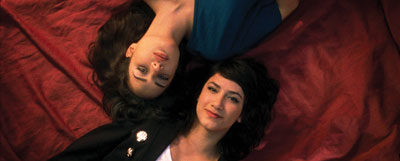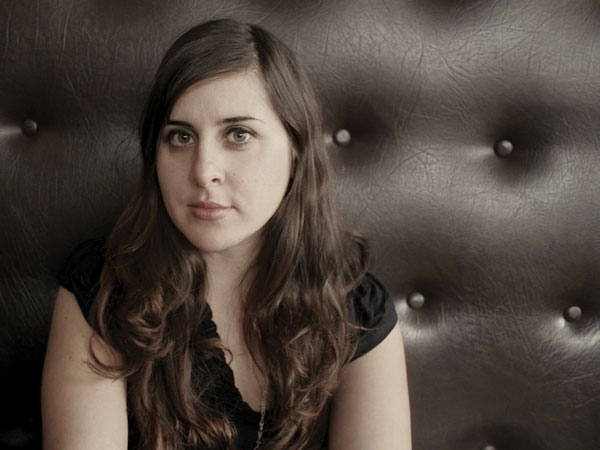The lesbian romance “Circumstance’ breaks many taboos, but for director Maryam Keshavarz, it was simply a story that had to be told.
The Arab Spring has meant a significant liberalization in Middle Eastern countries. But political freedom is one thing; artistic expression is still quite another. And, for that matter, Iran is not Egypt or Libya.
Not that the revolutions in those countries mattered to Maryam Keshavarz, who made the dauntingly radical film Circumstance. Although shot in comparatively open Lebanon (where it is still illegal to be gay), the story tells a tale of two Iranian woman who enter into a romance.
Keshavarz chatted with critics recently following a screening of her film to discuss how the film was made, the price she and the crew had to pay and what it’s like taking on taboo subject matter in a country where her film cannot even be shown.
Opens Friday at the Angelika Film Center Mockingbird Station.
………………….
Question: How much of the film is autobiographical? Maryam Keshavarz: It is not an autobiographical film, but the girls navigating the underground world is my experience as a teenager with my cousins. The structure of the family is based on a very liberal uncle I had that was at university in America, went back to Iran in 1979 and got stuck there. Since he was very liberal, I wondered what it was like for him to raise his family in a very conservative environment.
 Where was this movie made, when and how? The film was completely shot in Lebanon. We could not shoot in Iran due to the subject matter, but I wanted to shoot in the Middle East. Even shooting in a liberal country, like Lebanon, was still difficult. It is still illegal to be gay there. Also there is a lot of tension in the country.
Where was this movie made, when and how? The film was completely shot in Lebanon. We could not shoot in Iran due to the subject matter, but I wanted to shoot in the Middle East. Even shooting in a liberal country, like Lebanon, was still difficult. It is still illegal to be gay there. Also there is a lot of tension in the country.
As a filmmaker, did you run into backlash or difficulty making the project? There was a lot of risk in making the film. I had serious discussions with the actors that we likely couldn’t go back to Iran after making the film.
What has the reaction to the film been like in Middle Eastern countries? Unfortunately, we cannot show the film in Middle Eastern countries. The only countries that will show the film are Turkey and Israel. But we are trying to screen in other countries soon. There have been a lot of Middle Eastern immigrants who have seen the film and their reaction has been mostly positive, but some extremely negative. In terms of the young Middle Eastern and gay Middle Eastern, it has been extremely positive.
What has been the response from the gay community? The response in the gay community has been amazing. We won the audience award at Outfest and the Jury Award at New Fest.
What were your cinematic or visual cues that inspired the look and feel of the film? In terms of the visuals, I worked closely with my director of photography. I met him at the Sundance lounge in 2007. We created an 80-page look-book where we mapped out the entire course of the film. The beginning is open and airy, with smooth dolly shots, but as the film progresses, as the brother becomes more intrusive, the image becomes more crowded and darker to make a sense of unease.
Any specific films or filmmakers you modeled the film after? Or was it mostly intuitive or organic? I love Lucrecia Martel and Atom Egoyan.
Were you pressured at any point to walk your audience more explicitly through mile-markers of Iranian history and social context? I trusted the audience in making the film. In terms of when I write, I try to write scenes that resonate with me both as an Iranian and an American. I wanted people to feel the social context, not necessarily be told about it. We painted those strokes with camera and music. There are specific references to political ideologies. There’s the whole scene from Milk.
Did you always plan for dance and music to play such central roles? Yes, music has always been a major character in the film. Especially the use of Persian hip-hop in contrast to the Persian classical music. In the beginning of the film, there is a lot of music and joy. As the environment becomes more oppressive, the music that does appear is discordant. Gingger Shankar and I worked on the music cues even before we shot the film.
How open is the broader society to that kind of Persian hip-hop? Does it ever tackle these subjects directly in the music socially? Persian hip-hop is highly political. It’s all underground, but the lyrics are very political and it’s very popular with the young people in Iran. We will be releasing the soundtrack in November and there will be a booklet with the translations of the songs.
Can you talk about your upbringing? Are you able now to go back to Iran? I grew up going between New York, New Jersey and Shiraz. Since my parents came to the U.S. in ’67, I never had any issues going between countries. I had two passports. My uncle was killed in the war between Iran and Iraq. Because of this, my mom moved my brother and I back to Iran, so I actually went to second grade in Iran. I also did some of my graduate work at the university in Iran. I love that toggling back and forth.
How important was the influence of Marjane Satrapi [Persepolis] on you? I think Marjane and I both speak to a lot of Iranis’ experiences. I think what she did was only possible in animation. The broad historical analysis of a little girl.
Were there any specific challenges or issues with filming in the Middle East? Was production ever halted? I’ve shot two films in Iran before, so I know shooting in the Middle East is a very delicate matter. It’s about flying under the radar and picking the right team. We encountered some obstacles in terms of shutting down the production, but we were able to overcome them.
I like how we don’t know at first what headmistress means by “people like you,” and how you raise issues of wealth/class. Can you say more about that? “People like you” refers to Shireen’s parents’ political background. She’s been marked because of this. In terms of class, the film shows that the girls are on parallel paths until they are arrested. This is where circumstance of class comes in to play. Atafeh’s parents can buy her way out. Shireen’s choices are much more limited.
Did you specifically try to find a beautiful cast? Casting was a huge problem. I auditioned 2,000 girls for the roles of Atafeh and Shireen. I was looking for girls that were over 18, but looked under 18, had two passports, were good actors and weren’t afraid to tackle the subject matter in the film. It’s both girls’ acting debuts.
What are men most afraid of in regards to women in a culture like Iran? Women in Iran — it’s a touchy subject. Because it’s an Islamic state, women occupy a largely symbolic position in the culture. If women show too much of their hair or dress too promiscuously, this is an assault on the state. Women are largely more harassed in the culture. But it also creates very strong women as a result. The film is sort of a love poem to strong Iranian women, who in their daily lives and small acts stand up against the state.
Given the environment, why is there not a mass exodus of women? That’s not to say women don’t create their own spaces for freedom of expression. You have a sense in the beginning of the film that despite all the surveillance cameras, the girls have found a way to still live their lives. They ride around in the city, still see their friends — like typical teenagers. The family has done quite well for themselves. The mother is a successful surgeon. So in any oppressive environment, safe spaces are created. But I was trying to evaluate, when are those safe spaces compromised?
Are you currently working on any new, similarly risky projects? I’m working on a trilogy on Iran.
Surveillance cameras have become a way of life in all countries and cultures. How do you think this changes us fundamentally as human beings? It’s only when the threat comes from within that tragedy strikes. It’s when the brother brings the state [surveillance] into the sanctuary of the home that everything starts to fall apart.
Given Mehran’s arc, are you comfortable with viewers seeing his newfound fundamentalism as its own form of addiction? Is that too pat or a viable read of the character? Mehran’s not truly a fundamentalist. He’s attracted to religion because it comes with power in Iran. His extremism is another form of articulating his addictive character. But he’s quite lost and lonely. He’s disempowered. I don’t see him as a villain. Just as someone trying to find his place in the world.
This article appeared in the Dallas Voice print edition September 16, 2011.














